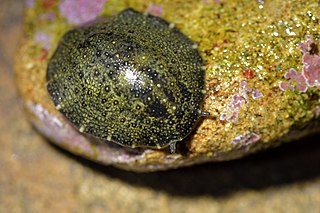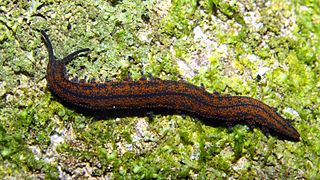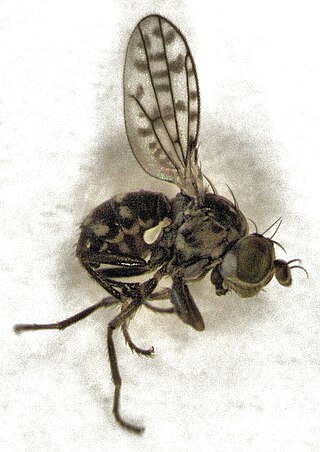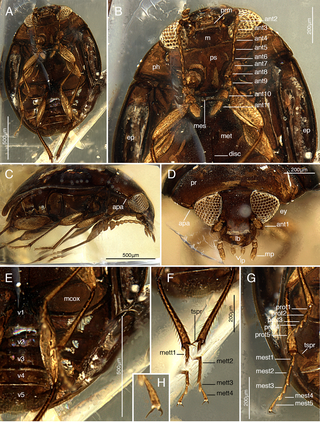Richard Kenneth Dell was a New Zealand malacologist.

Latridae commonly called trumpeters, is a family of marine ray-finned fish. They are found in temperate seas in the Southern Hemisphere. The classification of the species within the Latridae and the related Cheilodactylidae is unclear.They are fished commercially and for sport.
Zootaxa is a peer-reviewed scientific mega journal for animal taxonomists. It is published by Magnolia Press. The journal was established by Zhi-Qiang Zhang in 2001 and new issues are published multiple times a week. From 2001 to 2020, more than 60,000 new species have been described in the journal accounting for around 25% of all new taxa indexed in The Zoological Record in the last few years. Print and online versions are available.

Onchidella nigricans is a species of small, air-breathing sea slug, a shell-less marine pulmonate gastropod mollusc in the family Onchidiidae.

Peripatoides is a genus of velvet worms in the family Peripatopsidae, whose species are found in New Zealand. Like all velvet worms, these animals are nocturnal hunters that spit glue to trap their prey. Species of Peripatoides have 14, 15 or 16 pairs of legs. Female Peripatoides produce eggs that are fertilized internally and babies develop inside their mother until large enough to be born, in batches of 4-6, as colourless miniatures of the parents. These live-bearing Peripatoides have dermal-haemocoelic sperm transfer - which means sperm dissolve holes in the skin of the female to enter the body (haemolymph) anywhere on the body wall of the female.
William B. "Bill" Rudman is a malacologist from New Zealand and Australia. In particular he studies sea slugs, opisthobranch gastropod molluscs, and has named many species of nudibranchs.

The Ulodidae are a family of beetles belonging to Tenebrionoidea. They are native to the Southern Hemisphere, with species found in Australia, New Zealand, New Caledonia and Chile. Larvae and adults are generally found on dead wood or fungus associated with rotting wood, and are mycophagous. There are approximately 40 species in 16 genera.

The Diplodactylidae are a family in the suborder Gekkota (geckos), with over 150 species in 25 genera. These geckos occur in Australia, New Zealand, and New Caledonia. Diplodactylids are the most ecologically diverse and widespread family of geckos in both Australia and New Caledonia, and are the only family of geckos found in New Zealand. Three diplodactylid genera have recently been split into multiple new genera.
Peter Robert Last is an Australian ichthyologist, curator of the Australian National Fish Collection and a senior principal research scientist at CSIRO Marine and Atmospheric Research (CMAR) in Hobart, Tasmania. He is an elasmobranch expert and has described many new species of shark.
Miotadorna is a genus of extinct tadornine ducks from the Miocene of New Zealand. It contains two species, M. sanctibathansi, and M. catrionae.

Nostima duoseta is a species of shore fly.
Nostima niveivenosa is a species of shore flies in the family Ephydridae.

Nostima is a genus of shore flies in the family Ephydridae.

Limnellia is a genus of shore flies in the family Ephydridae.

Nostima picta is a species of shore flies in the family Ephydridae.

Ilytheinae is a subfamily of shore flies in the family Ephydridae.
Notiphila pulchrifrons is a species of shore flies.

Cyclaxyridae are a family of beetles in the superfamily Cucujoidea. The only living genus is Cyclaxyra, with two species endemic to New Zealand. Other species have been named from fossils. They are also known as sooty mould beetles due to the association of Cyclaxyra with sooty mould. The extant species are mycophagous, feeding on spores, conidia, and hyphae.

Epimetopidae is a family of semi-aquatic beetles belonging to the Hydrophiloidea. They are found in sand and gravel at the edges of streams, rivers and shallow freshwater ponds. These beetles are shorter than half a centimeter long and have a pronotum with a central projection forming a shelf above the head. On the underside of the abdomen only four sternites are visible. There are approximately 72 described species in three genera, Epimetopus which is restricted to the New World, mostly Neotropical, Eupotemus with two Afrotropical species and Eumetopus with some Oriental species. Females carry their eggcases on the underside of the abdomen. The larvae are probably carnivorous based on their mouthparts and likely live in the same habitats as the adults.










